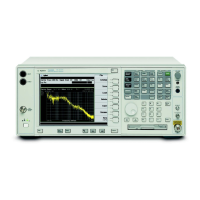Chapter 2 53
Overall Troubleshooting
Isolating the faulty assembly when the displayed amplitude is incorrect or the instrument fails
a gain related Auto Align test
Isolating the faulty assembly when the
displayed amplitude is incorrect or the
instrument fails a gain related Auto Align test
The PSA series analyzers contain two internal calibrators. Please refer
to the instrument overall block diagram under the block diagram tab in
this service guide.
The 50 MHz calibrator is located on the A10 3
rd
Converter, and provides
a 50 MHz, −25 dBm signal to the A14 Input Attenuator. This calibration
signal is used during most of the instruments auto align routine.
The 321.4 MHz calibrator signal is also generated on the 3
rd
Converter.
This calibration signal is used for a small portion of the auto align
routine and can only be manually controlled on instruments with
Option B7J (Digital Demod hardware) or instruments with Option 122
or 140. Switching on the 321.4 MHz calibrator allows verification of the
signal path and processing blocks from the 278.6 MHz notch filter on
the 3
rd
Converter assembly through the A7 Digital IF assembly. The 3
rd
Converter is located at about the halfway point in the signal path.
Therefore, checking the signal level at this point allows you to
determine which half of the signal path is faulty. Instruments without
option B7J require measuring the 2
nd
IF output port on the rear panel
with another spectrum analyzer to determine which half of the signal
path has a fault.
The following example illustrates how the internal calibrators and an
external source can be used to identify faulty assemblies.
1. Check the internal 50 MHz calibrator amplitude on screen.
Press the green
Preset key. Press Mode, Spectrum Analysis.
Press
Input/Output, Input Port, Amptd Ref, Frequency, 50 MHz, Span
1MHz
, Peak Search. The displayed amplitude should be −25 dBm.
If the internal 50 MHz calibrator amplitude is incorrect, the
calibrator may be faulty or one of the assemblies in the signal path
may be faulty. To determine if the internal calibrator is faulty,
perform the auto align using an external 50 MHz source connected
to the PSA RF input.
Connect a source to PSA RF input. Set source to 50 MHz and
−25 dBm. You should first measure the source and cable with a
power meter to assure the power level is correct.
On the PSA: Press
Input/Output, select Input Port RF. Press System,
More, More, Service. To enter the password, type -49 and press the
Enter key. Press the Service softkey again. Locate the 50 MHz Osc
softkey and toggle to
Ext. This will allow the Auto Align routine to

